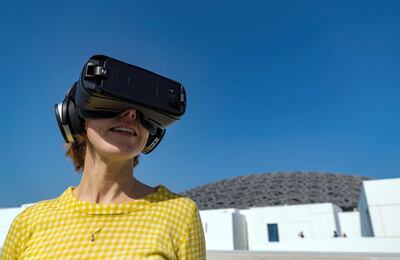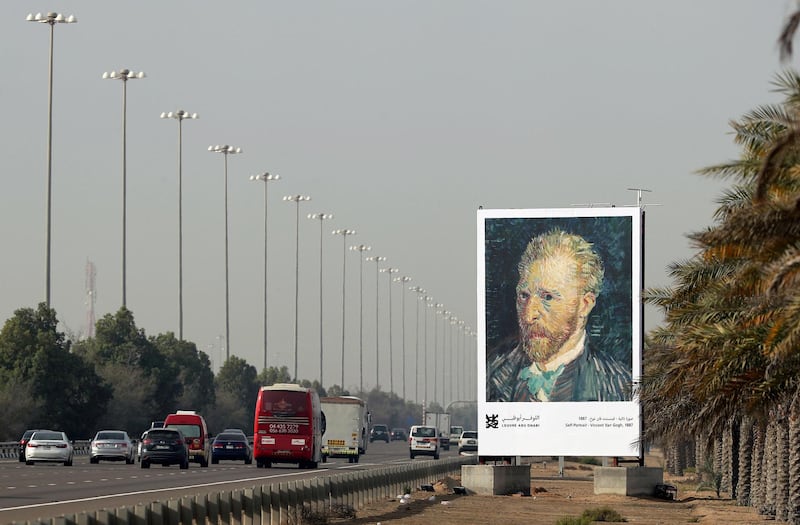The drive along Sheikh Zayed Road between Dubai and Abu Dhabi is an experience that is better lived than described. Bright lights flashing at you from a Nissan Patrol 2 metres from your bumper, the strange midway interlude of a green forest. The famous description of war – long patches of boredom punctuated by moments of terror – does not seem far off.
The road is indelibly a part of the Abu Dhabi and Dubai experience and now, true to UAE form, it takes its place in the Emirates' growing list of world firsts: it will be a museum esplanade in itself.
Louvre Abu Dhabi and Abu Dhabi Media have announced the Highway Gallery, in which billboards showing treasures from Louvre Abu Dhabi are placed along 10-kilometre intervals. Cars pass a trigger a few metres before the billboard, and if you are tuned to any of the three radio stations partnering on the project – Radio 1 FM (100.5 FM), Classic FM (91.6 FM) or Emarat FM (95.8 FM) – a short blurb on the artwork, or artefact, plays on the airwaves.
"We thought that for this month of innovation we are going to do something pioneering," says Saif Ghobash, the Director General Department of Culture and Tourism - Abu Dhabi (DCT). "We decided to launch the first-ever – in the world – roadside gallery. The concept is: you're on the highway for about an hour and a half and we have a lot of art here, and so we brought the art to you on the road. You can see a piece and listen to a nicely curated explanation of it. It's entertaining and educating for the driver, and for the children if they're in the car."
The 30-second audio discussions are written by the Louvre Abu Dhabi curators, and include major Louvre Abu Dhabi works and loans such as Piet Mondrian's Composition with Blue, Red, Yellow and Black (1922); the first work by Leonardo da Vinci ever shown in the Emirates, La Belle Ferronniere (1495-1499); and one of the oldest monumental statues still existing, a haunting sculpture of a two-headed figure from the Neolithic era (about 6500 BCE) that was found in Ain Ghazal, Jordan. ("No, you're not seeing double!" says the female voice introducing this last one.)
The initiative is part of DCT’s and Louvre Abu Dhabi’s broader programme to build an audience for art and increase cultural engagement in the Emirate. While the Louvre Abu Dhabi is becoming an international tourist destination, the Highway Gallery is aimed more at bringing local audiences and residents into the museum.
"Highway traffic is mainly used by residents," says Ghobash. "Part of our mandate is not only to build visitor figures but to get people to explore and interact with our message of cultural dialogue and interaction with the museum, so we took the message to them."
The selection of works, consonant with the museum's universal vision, stretches across time and geographical locations, from Egypt – the richly coloured sarcophagus of Hennuttawy (950-990 BCE) – to the United States. Nestled behind the metal barrier alongside the road is Louvre Abu Dhabi's iconic portrait of the US' first president, George Washington, which, you might learn if you are zipping by it, was actually painted 23 years after his death. Other works include Vincent Van Gogh's 1887 Self Portrait and a 2,000-year-old coin from the United Arab Emirates.

Pairing the billboards with the audio discussions allows Highway Gallery to function not only as teasers for the works in Louvre Abu Dhabi, but also as a mode of education. The spots will run in Arabic and English in the direction from Dubai to Abu Dhabi and the experiment will last for four weeks – marking the month of innovation. The transmitter on each of the boards is partly powered by solar energy.
“This road is so important, linking the two main cities,” says Manuel Rabate, the director of Louvre Abu Dhabi. “We thought, what can we add with an interesting, creative process? Let’s bring the content to the people, if they can learn something, we can change a little bit the monotony of the drive.”
________________
Read more:
Global Art Forum: What does artificial intelligence look like?
How the Saudi art scene is determined to keep up with the changes of its country
From One Louvre to Another tells the story of the Louvre in Paris
________________
One of the billboards shows the famous Mari-Cha lion (1000-1200), which stood next to kings and queens in Mediterranean palaces, but was made by Arab craftsmen. The bronze statue is one of the earliest known automata – mechanical figures that speak or move on their own – and the Louvre Abu Dhabi curators speculate that the Mari-Cha lion contains a mechanism by which moving its tail causes it to roar.
The radio spot ends with this – the lion's roar! Hopefully not a new moment of terror for the old Sheikh Zayed Road, but a way to make the drive home a little more special.
The Highway Gallery runs until mid-March, and can be seen when driving from Dubai to Abu Dhabi on the E11. The radio stations to tune into are 100.5 FM, 91.6 FM and 95.8 FM.






